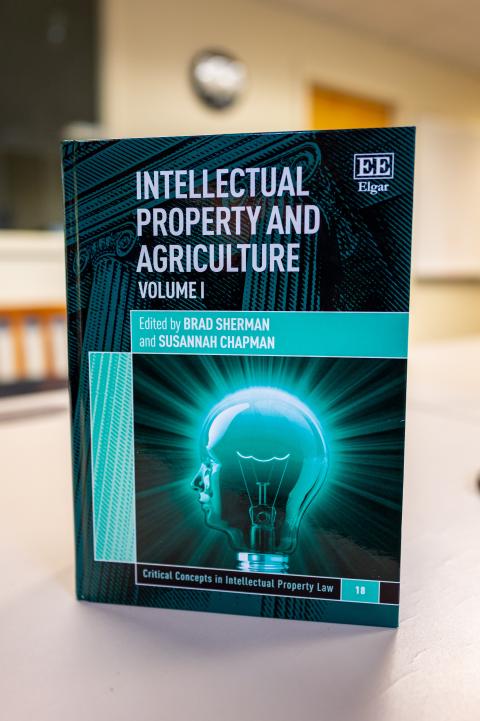Five Questions with Professor Stanley Kowalski: The Enduring “Golden Rice” Case Study

Forging connections between intellectual property, global health, food security, and biotechnology
Published by Prof. Stanley Kowalski twenty years ago in the final issue of the renowned peer-reviewed Franklin Pierce Law Center journal, RISK: Health, Safety & Environment, and one of the most popular downloads in UNH Franklin Pierce’s IP library, “Golden Rice: A Case Study in Intellectual Property Management and International Capacity Building”, has now been included in the prestigious Elgar compendium, Intellectual Property and Agriculture. This compendium is a collection of articles from the past century which have had significant impact in the field of intellectual property and agriculture.
Please provide a brief description of what your article is about and why you wrote it when you did. Why was it relevant then?
The Golden Rice RISK article has not only endured, but it has also gained scholarly momentum, as evidenced by numerous citations and over a thousand downloads. It is more topical now than when first published two decades ago. This remarkable endurance illustrates the continuing legacy of the Franklin Pierce Law Center, from its bold pioneering origin five decades ago to the present powerhouse, with Dean Megan Carpenter continuing to forge forward, opening new vistas, and creating new opportunities.
Golden Rice, genetically engineered rice which accumulates β-carotene (provitamin A) in the endosperm, is a harbinger of bio-innovation sorely needed to address looming global challenges in this century. As a complex agricultural biotechnological product comprising multiple inputs and processes, Golden Rice, required correspondingly sophisticated intellectual property management to reach those who most need it in their diets, that is, malnourished children suffering from vitamin-A deficiency, e.g., blindness, chronic illness, and mortality. The intellectual property embedded in Golden Rice was identified, analyzed, and then strategically accessed via creative licensing and technology transfer. Thus, the saga of Golden Rice represents a concise illustrative case study of how intellectual property and technology transfer can address and abate critical global issues in health, nutrition, and food security.

Why do you think it continues to be relevant today and is such a popular download in the IP library?
By forging connections between intellectual property, global health, food security and biotechnology, all in the context of international development, the article illustrates the power of merging intellectual property and the public interest. Specifically, the article has a key message: the importance of strategic management of intellectual property to accelerate research, development, assembly, and global access to critical bio-innovation in health and agriculture. Such bio-innovation includes improved crop varieties, green energy, medicines, and vaccines.
What are your thoughts on the growth of IP during the time between the two publications of this article—what’s different and what’s the same?
Over the past two decades, globalization has moved from being a somewhat arcane concept to a pressing reality. The coronavirus pandemic, climate change and biodiversity destruction illustrate this principle clearly and loudly. The RISK Golden Rice article provides a practical roadmap for meeting these challenges, that is, a systematic methodology to strategically manage intellectual property in order to accelerate global access to critical innovations in agriculture, green energy, and health. The problems of twenty years ago have simply magnified, and thus the relevance of the article has likewise increased.
What scholarship are you working on now?
Currently I am in the very early stages of researching and outlining a study which explores the interconnectedness of biodiversity and genetic resources, bio-innovation, intellectual property, and conservation. This study is in the context of the international treaty, the Convention on Biological Diversity (CBD), which aspires to balance access, use and conservation of genetic resources. This, of course, is related to climate change, emerging global health challenges and food security. It is both compelling and complex, to put it mildly. Management of intellectual property assets and strategic technology transfer will be key to developing sustainable systems. And as the case study of Golden Rice exemplifies, the urgency of such system development will increase as we traverse this century.
Anything else you’d like to share?
The RISK article on Golden Rice which I authored nearly two decades ago in a sense epitomizes the legacy of the Franklin Piece Law Center, and what it was so well known for: a pioneer, years ahead of all the rest, innovative, inclusive, interdisciplinary, and globally focused, tackling critical issues at the intersection of intellectual property, international development, and the public interest. And this tradition continues in new and exciting ways; it’s in our DNA. Under the visionary leadership of Dean Carpenter, the Franklin Pierce School of Law remains an innovative leader, with exciting programs, renowned faculty, and a forward-looking perspective. As a dynamic thought leader in the field of legal education and intellectual property, Dean Carpenter’s outside of the box approach has fostered a plethora of awesome and cutting-edge programs, decades ahead of the rest, innovative, bold, and courageous. Indeed, it is a safe prediction that scholarship that is current now, as the RISK Golden Rice article had been decades ago, will be even more impactful decades into the future, for example the Deflategate controversy (Prof. McCann), the “Slants” offensive, scandalous, and immoral trademark litigation (Prof. Roberts), and the intersection of copyright, pornography, and feminist legal theory (Prof. Bartow). All told, the pioneering legacy of the Franklin Pierce Law Center lives on in the Powerhouse.